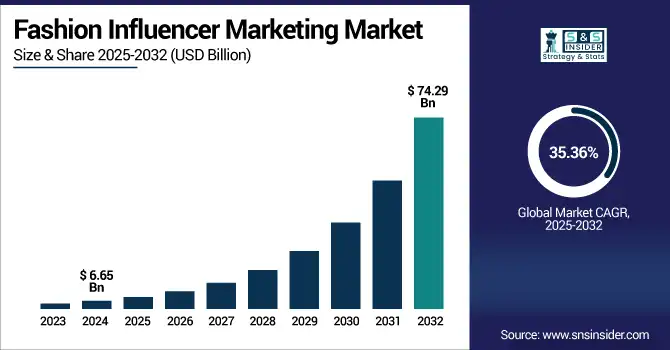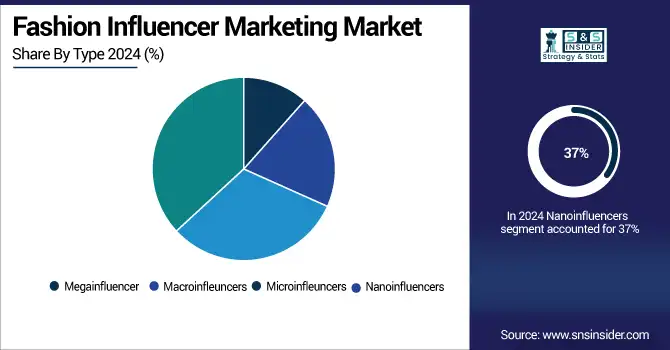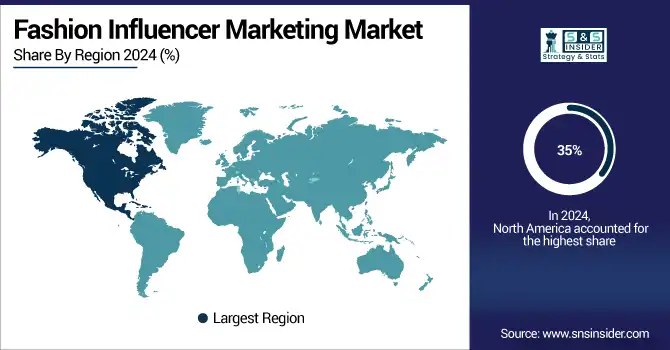Fashion Influencer Marketing Market Report Scope & Overview:
Fashion Influencer Marketing Market was valued at USD 6.65 billion in 2024 and is expected to reach USD 74.29 billion by 2032, growing at a CAGR of 35.36% from 2025-2032.

To Get more information on Fashion Influencer Marketing Market- Request Free Sample Report
The rapid growth of the Fashion Influencer Marketing Market is driven by the increasing reliance of fashion brands on social media platforms to reach targeted audiences with authenticity and engagement. Influencers offer personalized content that resonates with niche demographics, enhancing brand visibility and trust.
-
In 2025, spend on nano-influencers in the U.S. is forecasted to surge by 36.2%, with micro-influencer investment rising 25.3%, reflecting a shift toward more relatable and cost-effective collaborations.
-
Around 85% of marketers affirm influencer marketing as effective; 84.8% of e-commerce brands specifically report it working well, with 36% saying influencer content performs better than branded content.
The rise of e-commerce, especially among Gen Z and Millennials, is fueling demand for influencer-led product recommendations and style inspiration evident in the 61% of consumers who say they’ve purchased a product based on an influencer recommendation.
Technological advancements in AI-driven analytics now allow brands to measure ROI and target campaigns with greater precision. Meanwhile, live streaming, unboxings, and short-form video content on platforms like Instagram, TikTok, and YouTube are further amplifying market expansion.
-
At Cannes 2025, luxury and fashion influencers generated a record USD 203 million in Earned Media Value (EMV) on Instagram USD 77.2 million from fashion alone with Gucci leading at USD 12.6 million, highlighting the commercial impact of influencer partnerships in high-visibility events.
U.S. Fashion Influencer Marketing Market was valued at USD 1.63 billion in 2024 and is expected to reach USD 17.90 billion by 2032, growing at a CAGR of 34.88% from 2025-2032.
The U.S. Fashion Influencer Marketing Market is growing due to high social media penetration, increased digital ad spending by fashion brands, and consumer preference for influencer-driven content that offers authenticity, trend alignment, and direct engagement across platforms like Instagram, TikTok, and YouTube.
Fashion Influencer Marketing Market Dynamics
Drivers
-
Surging Social Media Penetration and Mobile Usage Across Gen Z and Millennials Is Accelerating Fashion Influencer Marketing Engagement Worldwide
Growing access to smartphones and social media platforms has fueled direct consumer engagement with fashion influencers. Platforms like Instagram, TikTok, and YouTube have created an ecosystem where Gen Z and millennials trust peer-like endorsements over traditional advertising. This trend allows fashion influencers to showcase products authentically, leading to higher conversion rates and brand loyalty. Brands increasingly allocate budgets to influencer partnerships as these digital voices effectively bridge product visibility with consumer intent. The rise in user-generated content and live shopping further enhances influencer impact, making fashion influencer marketing a vital tool in digital commerce and trendsetting.
-
In March 2025, Unilever announced that 50% of its media budget would shift toward social platforms, with a commitment to working with 20× more creator-level influencers than before marking a strategic pivot to prioritize social engagement over traditional advertising channels.
Restraints
-
Growing Concerns Over Fake Followers and Inauthentic Engagement Are Undermining Trust in Fashion Influencer Marketing Campaigns
The widespread use of bots and purchased followers by some influencers has raised concerns about the authenticity of engagement metrics. Brands relying on follower counts and likes may miscalculate ROI when these metrics are artificially inflated. This lack of transparency damages brand reputation, reduces campaign effectiveness, and discourages long-term partnerships. As consumers become more discerning, they may lose trust in influencer-promoted content perceived as disingenuous. The challenge of verifying influencer credibility and aligning with authentic voices creates friction in campaign execution, leading many brands to adopt stricter vetting procedures or shift to influencer discovery tools with performance analytics.
-
Nearly 49% of Instagram influencers globally have fake followers, and 24% manipulate engagement figures, with 60% using artificial growth tactics. Additionally, approximately 9.5% of Instagram accounts are estimated to be bots, which severely distort engagement data.
Opportunities
-
Expansion of Virtual Influencers and AI-Powered Avatars Is Unlocking Scalable, Customizable Fashion Marketing Experiences
Technological advancements in AI and digital animation are giving rise to virtual influencers computer-generated avatars that promote fashion without human limitations. These influencers offer brands full creative control, 24/7 availability, and consistent branding. They can be tailored to appeal to specific demographics and used across global campaigns without concerns of personal controversies. As the metaverse and digital fashion gain momentum, virtual influencers offer immersive marketing experiences that blend gaming, shopping, and social engagement. This shift enables fashion brands to experiment with futuristic storytelling and expand their digital presence while reducing dependency on unpredictable real-world influencers.
-
Brazil’s retail giant Magazine Luiza created its virtual influencer Lu of Magalu, who has amassed 7.1 million Instagram followers and drives strong engagement and product reviews.
-
63 % of marketing professionals plan to leverage AI/ML to create or manage virtual influencers in upcoming campaigns.
-
Leading fashion agencies and luxury brands like Gucci, Dior, Louis Vuitton, H&M, and Zara are now regularly incorporating virtual influencers into digital campaigns & metaverse activations, with an expected shift of 25 % of all brand influencer partnerships projected to involve virtual talent by 2026.
Challenges
-
Audience Fatigue from Oversaturation of Sponsored Content Is Reducing Engagement and Campaign Effectiveness in Fashion Influencer Marketing
The rapid growth of influencer marketing has led to an overwhelming amount of sponsored content, resulting in reduced consumer responsiveness. As followers are bombarded with promotional posts, the perceived authenticity of influencers diminishes, weakening the impact of their recommendations. This saturation makes it difficult for brands to stand out, even when collaborating with top-tier influencers. Consumers increasingly skip or ignore branded content, demanding more transparency and creativity. Maintaining engagement requires constant innovation in content formats and storytelling. Without distinct messaging and meaningful influencer-brand alignment, campaigns risk fading into digital noise, weakening brand influence and long-term marketing returns.
-
A study by InfluencerDB showed Instagram influencer engagement rates have dropped from 4% to 2.4%, attributed to the overload of sponsored content causing influencer posts to lose visibility and impact.
-
Nearly 70% of consumers report they are bothered when an influencer is not transparent about sponsorships and 20% say they would stop following the influencer in such cases.
Fashion Influencer Marketing Market Segmentation Analysis
By Fashion Category
The Apparel segment dominated the Fashion Influencer Marketing Market in 2024 due to its universal consumer demand, visual appeal, and adaptability across digital platforms. Influencers effectively showcase apparel through try-ons, hauls, and styling content, driving high engagement and purchase intent. The segment also benefits from seasonal trends and fast fashion cycles, ensuring continuous brand-influencer collaborations and repeat campaigns that sustain visibility and drive revenue consistently.
Streetwear / Casual Fashion is projected to grow at the fastest CAGR of 39.45% from 2025 to 2032, fueled by youth culture, urban style appeal, and social media influence. Streetwear aligns closely with influencer aesthetics and is often associated with exclusivity, drops, and limited editions. Influencers serve as key tastemakers, driving hype and brand loyalty. The segment’s cultural relevance and crossover with music and lifestyle further accelerate its digital traction.
By Campaign Type
The Sponsored Content segment led the market in 2024 with a 31% revenue share, owing to its flexibility, cost-effectiveness, and high scalability. Brands prefer sponsored posts for their easy integration into influencer feeds and stories, enabling widespread reach without long-term commitment. The format supports quick campaign rollouts across multiple platforms and allows data-driven performance tracking, making it the preferred choice for fashion marketing strategies with short turnaround goals.
Brand Ambassadorships are expected to grow at a CAGR of 38.90% between 2025 and 2032 due to their long-term brand association benefits and trust-building potential. Consumers perceive ambassadors as authentic brand advocates, which enhances loyalty and purchase intent. Ambassadorships offer consistent exposure, deeper storytelling, and cross-platform synergy, allowing brands to establish sustained visibility and emotional connections with targeted audiences through curated, recurring influencer engagement.
By End User
Beauty & Cosmetic Companies led the market in 2024 with a 37% revenue share due to their heavy reliance on influencer reviews, tutorials, and product demos. The beauty industry thrives on visual validation, making influencer content particularly effective. Cosmetics offer rapid trial-to-purchase cycles, enabling high campaign ROI. The constant launch of new products further sustains demand for continuous influencer-led promotional activities.
Fashion Brands are expected to grow at the fastest CAGR of 37.55% from 2025 to 2032, driven by rising e-commerce penetration and consumer dependence on influencer-curated trends. Influencers help fashion brands differentiate in crowded markets through unique styling content and real-time trend alignment. Collaborations, capsule collections, and digital runway previews further amplify reach. As direct-to-consumer models expand, influencer partnerships become central to visibility and conversions.
By Type
Nanoinfluencers held the largest market share at 37% in 2024 due to their hyper-engaged audiences and authenticity. Their smaller but highly interactive followings yield higher engagement rates and conversion levels compared to larger influencers. Brands capitalize on this trust factor to drive word-of-mouth promotions in targeted communities. Additionally, campaigns with nanoinfluencers are budget-friendly and scalable, making them ideal for micro-targeted marketing in fashion.
Microinfluencers are set to grow at a CAGR of 36.80% from 2025 to 2032, fueled by their balance between reach and relatability. They maintain strong audience trust while offering greater scale than nanoinfluencers. Their content often appears more organic, boosting credibility and consumer response. Microinfluencers also cater to specific fashion niches, allowing brands to execute segmented campaigns that align with community interests and aesthetic preferences.

Fashion Influencer Marketing Market Regional Analysis
North America dominated the Fashion Influencer Marketing Market in 2024 with a 35% revenue share due to its mature digital ecosystem, high influencer adoption, and well-established brand-influencer networks. The region hosts major social media platforms and leading fashion brands that heavily invest in influencer-led campaigns. High consumer spending, advanced analytics tools, and widespread mobile usage further support the region’s leadership in fashion influencer marketing effectiveness and scale.
The United States is dominating the Fashion Influencer Marketing Market due to its large influencer base, advanced digital platforms, and strong brand partnerships.
Asia Pacific is projected to grow at the fastest CAGR of 37.73% from 2025 to 2032, driven by rapid smartphone adoption, booming e-commerce, and expanding youth populations. Countries like China, India, and Indonesia are witnessing explosive growth in digital engagement and fashion consumption. The rise of local influencers, short-form video platforms, and mobile-first shoppers are propelling fashion brands to prioritize influencer strategies in this high-growth, trend-driven regional market.
China is dominating the Fashion Influencer Marketing Market in Asia Pacific due to its massive consumer base, thriving e-commerce, and highly active social media ecosystem.
Europe holds a strong position in the Fashion Influencer Marketing Market due to its established fashion culture, widespread digital adoption, and high social media engagement. Influencers across the region drive trend-forward content, brand visibility, and consumer trust through visually rich storytelling.
The United Kingdom is dominating the Fashion Influencer Marketing Market in Europe due to its strong fashion culture, digital maturity, and high influencer engagement rates.
Middle East & Africa and Latin America are emerging markets in Fashion Influencer Marketing, fueled by rising smartphone usage, youth-driven social media adoption, and growing interest in fashion trends. Local influencers are gaining traction, boosting brand engagement and digital outreach.

Get Customized Report as per Your Business Requirement - Enquiry Now
Key Players
Fashion Influencer Marketing Market companies are rewardStyle, Inc., MomentIQ, sway group, Ykone Group, CURE MEDIA (Online Media Sweden AB), AspireIQ, Inc., Brain Labs Digital Ltd, TEAM EPIPHANY, Billion Dollar Boy, JMB GLAMSQUAD, LLC, Influencity, Pearpop, ShopMy, Grin, Upfluence, CreatorIQ, Modash, Lefty, InfluData, Afluencer.
Recent Developments:
-
2025: AspireIQ rolled out in 2025 a fully customizable Influencer CRM and comprehensive ROI‑measurement suite for ecommerce brands, enabling scalable campaigns, content repurposing, ambassador programs, and advanced analytics.
-
2024: AspireIQ launched a customizable Influencer CRM and full-suite ROI measurement tools for ecommerce brands, enabling scalable campaigns, content repurposing, long-term ambassador programs, and advanced analytics to optimize influencer ROI.
| Report Attributes | Details |
|---|---|
| Market Size in 2024 | USD 6.65 Billion |
| Market Size by 2032 | USD 74.29 Billion |
| CAGR | CAGR of 35.36% From 2025 to 2032 |
| Base Year | 2024 |
| Forecast Period | 2025-2032 |
| Historical Data | 2021-2023 |
| Report Scope & Coverage | Market Size, Segments Analysis, Competitive Landscape, Regional Analysis, DROC & SWOT Analysis, Forecast Outlook |
| Key Segments | • By Type (Megainfluencer, Macroinfluencers, Microinfluencers, Nanoinfluencers) • By End User (Fashion Brands, Retailers & E-commerce Platforms, Fashion Designers & Boutiques, Beauty & Cosmetic Companies, Lifestyle Brands) • By Campaign Type (Sponsored Content, Product Reviews, Giveaways & Contests, Affiliate Marketing, Brand Ambassadorships, Live Streaming/Unboxings) • By Fashion Category (Apparel, Footwear, Accessories, Beauty & Cosmetics, Luxury Fashion, Streetwear / Casual Fashion, Sustainable Fashion) |
| Regional Analysis/Coverage | North America (US, Canada), Europe (Germany, UK, France, Italy, Spain, Russia, Poland, Rest of Europe), Asia Pacific (China, India, Japan, South Korea, Australia, ASEAN Countries, Rest of Asia Pacific), Middle East & Africa (UAE, Saudi Arabia, Qatar, South Africa, Rest of Middle East & Africa), Latin America (Brazil, Argentina, Mexico, Colombia, Rest of Latin America). |
| Company Profiles | rewardStyle, Inc., MomentIQ, sway group, Ykone Group, CURE MEDIA (Online Media Sweden AB), AspireIQ, Inc., Brain Labs Digital Ltd, TEAM EPIPHANY, Billion Dollar Boy, JMB GLAMSQUAD, LLC, Influencity, Pearpop, ShopMy, Grin, Upfluence, CreatorIQ, Modash, Lefty, InfluData, Afluencer |

